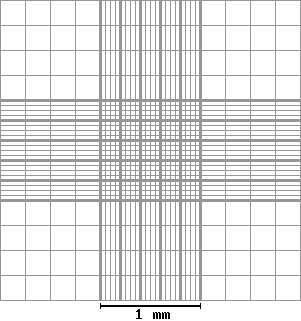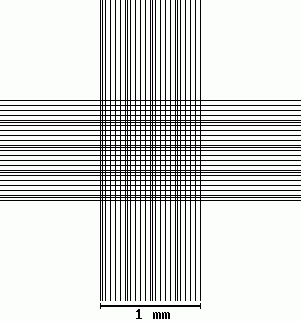Yeast counts in Neubauer improved or Thoma counting chambers
Introduction to counting chambers
|
Experiments or studies that work with cells require the cells in known and suitable
quantities. There are different methods used to count the cells in a cell suspension.
Despite great advances in science, even today one of the most widely used methods,
due to its simplicity and low cost, is the direct microscopic observation and counting
of cells in cell counting chambers or haemocytometers.
There are many different counting chambers, but their basic usage is common to all of
them. The counting chamber is a special slide with a frame of known surface marked on it,
wherein a fixed volume of the cell suspension under study is placed. By counting the cells
in that particular volume under the microscope, the concentration of cells in the sample
can be estimated. Although these frames can vary a lot (they can be subdivided in different
ways), they usually delimit a square surface of 1 mm/side (1 mm2), which is then subdivided
into smaller squares. When the sample is placed in the chamber and the cover glass is
in the proper position, the sample reaches in most chamber models a height of 0.1 mm.
Thus, by counting cells located in the counting area the number of cells in 0.1 microliters
are accounted (1 mm2 x 0.1 mm = 0.1 µl = 10-4 ml).
If instead of counting all the cells in all squares in the 1 mm2 area, cells are counted
in fewer squares (for example, when the number of cells in each of the squares is very high),
contiguous squares should not be counted. In this case, the medium squares in the corners
and the one in the center are usually counted, and the data will be extrapolated
to estimate the number of cells in the total 1 mm2 area .
Specific information on Neubauer improved counting chamber
Specific information on Thoma counting chamber
External links
| |
Note to Teachers
If you want to use this service for educational propose the following procedure is suggested:
- Provide students with the URL of this page.
- Tell the student to count the yeasts in one of the counting chambers and to solve the problems.
-
In case the teacher wants to control the activity, it is suggested that students generate
aspecific 8-digit number to receive a corresponding problem, then solve the exercise and
deliver it for correction. The teacher can access the solved problems here.
| |
Exercise number: 63113570 Show a different problem
Please read the entire page before proceeding to solve the problem.
From a yeast suspension two decimal dilutions were obtained up to 10-2 dilution.
Ten microliters of the dilution were transferred to an improved Neubauer counting chamber and
another ten to a Thoma counting chamber.
Count the cells in the counting chamber and calculate the concentration of yeasts in
the initial suspension. Then, find out how to obtain the following suspensions of
microorganisms:
- A suspension of 2 ml with a concentration of 5 x 106 yeast/ml.
- A suspension of 3 ml with a concentration of 5 x 108 yeast/ml.
To count cells click on the counting chamber (Neubauer or Thoma) you want to use.
more info
|
A new window will be opened with a representation of the selected counting chamber.
The resulting image is substantially larger than the screen.
It is likely that the browser will fit the image to the browser's window, so that the
resolution of the image will be very poor. In this case, click on the image to view
the full size image. The user will need to use the scroll bars to locate the counting
area of the counting chamber in order to count the yeasts. This process resembles the
microscopic observation of the counting chamber with a 40X objective, and it is intended
to be used for familiarization with the counting chamber that later could be used in
the laboratory.
To solve the exercise, all yeasts in the central big square of the counting chamber
must be counted (25 medium squares in the improved Neubauer chamber or 16 medium
squares in the Thoma chamber). Both counting chambers will lead
to the same result if the center of the counting chamber is counted.
Them, the concentration of the undiluted yeast suspension
must be calculated and the necessary calculations to solve the proposed questions
must be computed.
|
Counting Chamber: Neubauer improved

|
Counting Chamber: Thoma

|
Dilution: 10-2
|

